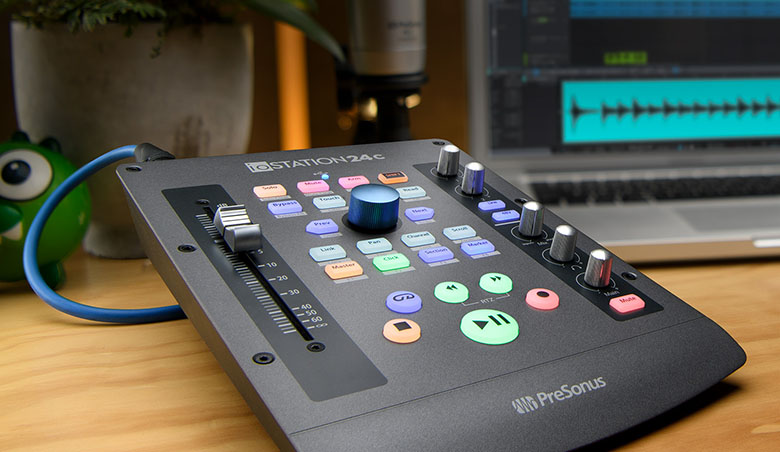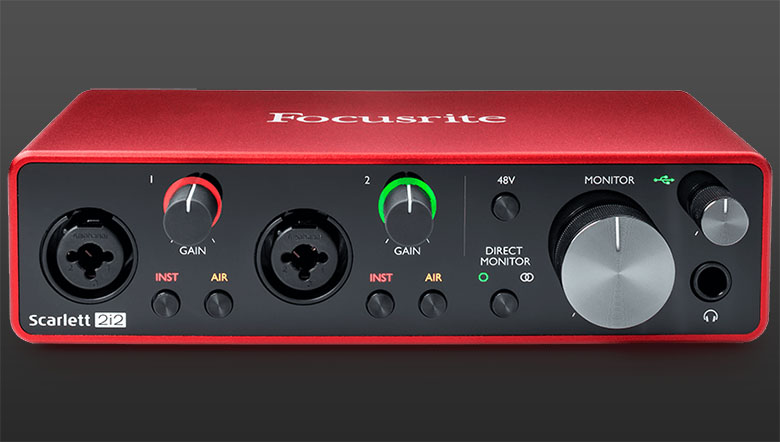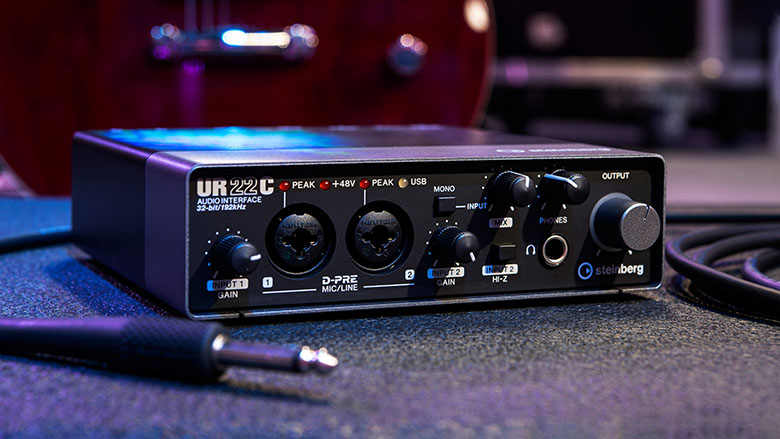In this post, I’ll be digging into low-cost audio interfaces. Instead of listing every budget interface known to man, which seems to be the custom in articles like this ($$$), I’m limiting this round-up to my own personal recommendations. I’ll provide some more options in summary at the end for a broader overview of what’s out there.
The truth is, most budget interfaces on the market—at least those from reputable, long-standing manufacturers–will get the job done, and they’ll do it reasonably well.
Any entry-level unit from Focusrite, Presonus, MOTU, Audient, M-Audio,Steinberg, Native Instruments, or even the oft-maligned Behringer will provide you with the specs and tools you need to produce a recording many people would be unable to differentiate from one made with hardware costing hundreds of dollars more. Dynamic range, latency, and other performance metrics will vary marginally, but not substantially.
And unless you’re doing this professionally, or have considerably more disposable income than I have, I think expensive interfaces of the UAD and RME variety are overkill for hobbyists and home recording. You’d be better off spending that excess cash on a quality microphone or better guitar pickups. But I’ve also spent countless hours trying to mimic the sound of old black metal albums like Darkthrone’s Transilvanian Hunger, so “pristine” isn’t exactly my wheelhouse.
This list is also limited to interfaces with only a couple inputs and outputs. If you plan on frequently tracking live drums, for example, you going to have to spend a bit more. But that’s another article for another time. So, let’s get into it.
PreSonus ioStation 24c

The Presonus ioStation my primary interface, and the one I use on a daily basis. It replaced a first-gen Focusrite unit, which I loved–but it was becoming dated, and was beginning to introduce latency issues.
Before landing on the ioStation, I briefly tried an Audient EVO, partly seduced by the form factor. (If you’re unfamiliar with the EVO, it’s an unassuming little box with a single knob).
I ended up being unhappy with it for a few reasons. I was enticed by the JFET guitar input, but unlike my Focusrite, the interface introduced puzzling spikes of noise into the signal that played poorly with my amp sims. I’m not entirely certain whether the source was the JFET, or electrical interference, since the build quality and plastic construction left a lot to be desired, too. At any rate, I tried hard to find the cause, and finally gave up and returned it.
The ioStation impressed me immediately, and after a year of use, I’ve had no issues with it whatsoever. On the audio end, it’s a noticeable improvement over the older Focusrite it replaced, and added some life to my DI guitar tracks and bass.
The contruction is a hard plastic, and unlike the EVO, feels very solid. With my buffer set to 64, the roundtrip latency is about 5.3ms. Even if it isn’t the lowest latency unit on this list (MOTU has that distinction), it’s plenty low enough.
But I’m burying the lead a bit: the feature the ioStation has that my other picks do not is a control surface, complete with a motorized fader. The transport controls alone have proved tremendously useful, to the extent that I no longer feel I could live without them. While support for my preferred DAW, Reaper, is a bit spotty (though highly functional, after some workarounds, and not a deal breaker), it works flawlessly out of the box with my second-choice DAW, Presonus’s own Studio One.
Which brings me to the bundled software. In addition to a few plugins I haven’t used and I’ll likely never use, it comes with a license for Studio One Artist. While Artist strips out a few features from the Professional edition, there’s really nothing about this version that feels “Lite”, or unreasonably restricted (compared to, for example, the mostly useless entry-level edition of Pro Tools).
Another thing worth mentioning is that this interface is not powered via USB. You plug it into an ol’ fashioned wall outlet. While this may sound inconvenient, it’s the better option, particular for home studios. It helps to keep obnoxious EM interface out of the signal, which are more likely to creep in in environments that aren’t built with audio recording in mind.
Perhaps counter-intuitively, the actual technical specs of the unit don’t really factor into my recommendation—as stated in the introduction, most budget interfaces are on par with one another, making the build quality and unique features of the device the deciding factor. But if you’re interested, you can check them out here.
While this is the most expensive option on the list, retailing at around $320, I think the addition of the control surface more than justifies the price tag.
MOTU M2

Before pulling the trigger on the ioStation, the MOTU M2 was a strong contender. Granted, I don’t have enough experience with it to provide a long-term impression, but despite lacking the control surface of the Presonus unit, it checks all of the other boxes. It’s also the most well-reviewed interface in the price range, and could just easily take the top spot if not for my ownership bias.
No matter what genre you’re focused on, low latency is better. I’m admittedly a bit obsessed with latency—perhaps irrationally so—but that likely comes from recording extreme metal in particular. If you’re recording music filled with 16th notes, blasting away at tempos over 200bpm, you need those performances to be as tight as you can possible make them, or risk drifting into chaos. The last thing you want is for an exacting performance to be hobbled by limitations of the hardware. So, good news: the MOTU M2 offers the lowest latency you’ll find in this price range, besting interfaces that cost hundreds more.
Another unique (to the price range) feature of this interface is full color, LCD metering that is actually useful. Some budget interfaces include half-assed metering with LEDs, which looks good in the marketing, but I’ve found it doesn’t really translate to having much value in the real world.
To briefly touch on specs, another thing the MOTU M2 has going for it: a ESS Sabre32 Ultra DAC, offering a dynamic range of 120db, a DAC that is typically found in audio gear that is considerably more expensive. Will a novice be able to tell? Probably not, but an intermediate might, and no one stays a novice forever.
The bundled software includes two DAWs, the Lite version the popular Abelton Live (A DAW I’ve personally never connected with, but has many die-hard fans) and MOTU Digital Performer, one of the few DAWs I have never used.
You can check out more details and the in-depth technical specifications here. It typically retails for about $260.
Focusrite Scarlett 2i2

The Scarlett 2i2: a stone-cold classic. My first-gen Scarlett was my interface for years. It served me well, and the only reason I moved on from Focusrite at all was my dumb human need to seek novelty. In fact, I very nearly purchased the latest build, until I started poking around online and saw the motorized fader of the ioStation. Which, by the way, I never actually use. But I know that it’s there. And motorized!
It’s built tough, with metal casing, and the front panel is a durable, hard plastic. It does lack the bells and whistles of the ioStation, and at least one notable feature of the MOTU M2, the LCD metering. But in terms of performance and audio quality, it’s an easy recommendation. It also costs slightly less, coming in at around $239. And if you don’t need two XLR inputs, the Scarlett Solo offers up the same audio quality and performance at an even lower price. Tough to beat.
The bundled DAW is once again Abelton Live Lite. And, I guess, Pro Tools First, which I’m not sure I would recommend to anyone who wasn’t pursing an actual career in the industry—there’s educational value. To be clear: it’s not that I have anything against Pro Tools, just Pro Tools First.
You can check out further details and specs here.
Steinberg UR22C MKII

The UR22C is the most afforable option on this list coming in at around $200, and yet it has one distinct feature you don’t typically see in budget interfaces: on-board DSP effects, inspired by higher end hardware from companies like Universal Audio and Arturia. There’s dedicated processing for a channel strip, reverb, and amp simulation, with corresponding plugins you can load up in your DAW and apply with zero-latency.
Although I’m addicted to amp sims, I’m also very particular, and I must admit the ones included with the UR22C don’t excite me much. But I’m much less particular about EQs, compressors, and reverbs, and being able to add these to a track without eating into the CPU is extremely appealing. Had this been on my radar at the time I purchased my Presonus unit, it definitely would have been a contender.
Once again the technical specs are about what you’d expect for an interface in this class. The DAC isn’t as fancy as the MOTU M2 DAC, but the preamps and solid build are certainly on par with my Focusrite and Prenonus recommendations. Like the ioStation, the power does not rely on the USB, but you can switch to USB power if you want. Also like the ioStation, there’s no metering other than LEDs that burn red when you push the signal too far. But for me, that’s not a deal breaker.
The bundled DAW is the LE version Cubase , my third-choice DAW, and like Studio One Artist, it’s has more than enough functionality to meet the needs of beginners and intermediates.
You can find more details and specifications here.
Summary
Clearly, this short list scratches only the surface of available options; they’re just the interfaces I’d personally recommend to a friend looking to get into home recording. So in closing, here’s a few other well-regarded audio interfaces worth looking into, if the ones I’ve covered don’t hit the spot.
Presonus’s Studio 24c (Essentially the ioStation without the control surface at a lower price)
Universal Audio’s Volt 2 (Recent entry-level interfaces from a company famous for it’s mid-range and high-end hardware)
Arturia’s Minifuse 2 (Like Universal Audio, these are Arturia’s answer to budget interfaces)
M-Audio’s M-Track Duo (Great performance for a low price)
